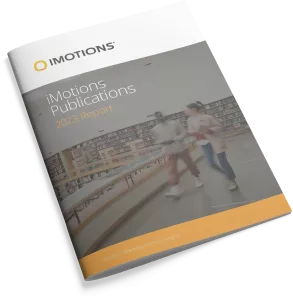-
Reducing Sketch Inhibition During Concept Generation: Psychophysiological Evidence of the Effect of Interventions
Abstract: This research investigated the effect of warm-up activities on cognitive states during concept generation. Psychophysiological tools including electroencephalography (EEG) and galvanic skin response (GSR) were used along with self-report measures (NASA TLX). Participants were divided into 3 test conditions: 1) no warm-up activity; 2) simple warm-up activities; 3) sketch-inhibition reducing activities. All participants did […]
-
Enhancing the Professional Vision of Teachers: A Physiological Study of Teaching Analytics Dashboards of Students’ Repertory Grid Exercises in Business Education
This paper reports on a study of the design, development and evaluation of two teaching analytics dashboards that visualize students’ repertory grid exercise data. The technical objective of the dashboards is to support teachers to investigate and compare personal constructs and element ratings by students for given topics of study at the individual student, group […]
-
The Role of Pedagogical Agents on Learning: Issues and Trends
Abstract: Research on the effectiveness of Advanced Learning Technologies (ALTs) on ubiquitous learning has suggested that students are often poor at self-regulating their learning (Azevedo, Taub, & Mudrick, 2015), and as a consequence, researchers have implemented Pedagogical Agents (PAs) to help foster students’ use of Cognitive, Affective, Metacognitive, and Motivational (CAMM) Self-Regulated Learning (SRL) processes […]
-
Enhancing the Professional Vision of Teachers: A Physiological Study of Teaching Analytics Dashboards of Students’ Repertory Grid Exercises in Business Education
Abstract: This paper reports on a study of the design, development and evaluation of two teaching analytics dashboards that visualize students’ repertory grid exercise data. The technical objective of the dashboards is to support teachers to investigate and compare personal constructs and element ratings by students for given topics of study at the individual student, […]
-
Physiology-based recognition of Facial micro-expressions using EEG and identification of the relevant sensors by emotion
Abstract: In this paper, we present a novel work about predicting the facial expressions from physiological signals of the brain. The main contributions of this paper are twofold. a) Investigation of the predictability of facial micro-expressions from EEG. b) Identification of the relevant features to the prediction. To reach our objectives, an experiment was conducted […]
-
Investigation of Facial Micro-expressions of Emotions in Psychopathy – A Case Study of an Individual in Detention
Abstract: This paper explores the relationship between emotional triggers and various types of (positive / negative) facially displayed emotions by a subject from custody, diagnosed with psychopathy. In this case study, FME were manually measured by using the Facial Action Coding System (FACS, Ekman, Friesen, Hager, 2002), which taxonomies human facial movements by their appearance. […]
-
A survey of technologies on the rise for emotion-enhanced interaction
Abstract: Emotions are a major part of the human existence and social interactions. Some might say that emotions are one of the aspects that make us truly human. However, while we express emotions in various life settings, the world of computing seems to struggle with supporting and incorporating the emotional dimension. In the last decades, […]
-
Differential emotion attribution to neutral faces of own and other races
Abstract: Past research has demonstrated differential recognition of emotion on faces of different races. This paper reports the first study to explore differential emotion attribution to neutral faces of different races. Chinese and Caucasian adults viewed a series of Chinese and Caucasian neutral faces and judged their outward facial expression: neutral, positive, or negative. The […]
-
Anticipatory Gaze Shifts during Navigation in a Naturalistic Virtual Environment
Abstract: In the real world, coupled eye and head movements are used by humans and other animals to orient their gaze toward objects or scenes of interest. In virtual environments a mouse is often used as a proxy for head movements, orienting the camera towards a desired view direction. The mouse also controls body direction […]
-
Emergency, Automation Off: Unstructured Transition Timing for Distracted Drivers of Automated Vehicles
Abstract: In future automated driving systems, drivers will be free to perform other secondary tasks, not needing to stay vigilant in monitoring the car’s activity. However, there will still be situations in which drivers are required to take-over control of the vehicle, most likely from a highly distracted state. While highly automated vehicles would ideally […]
Research Report 2023
In-depth look at the scientific landscape as powered by iMotions software, showcasing groundbreaking research and the impact of our tools in various scientific and industrial fields.

Share Your Research

850+ universities worldwide with an iMotions human behavior lab
73 of the top 100 highest ranked universities
710+ published research papers using iMotions
iMotions is used for some of the most interesting human behavior research studies carried out by top researchers around the world. Contact us to have your publication featured here.
The authors of these publications have used iMotions as a software tool within their research.
“Software should be cited on the same basis as any other research product such as a paper or a book; that is, authors should cite the appropriate set of software products just as they cite the appropriate set of papers” (Katz et al., 2020).
We therefore encourage you to cite the use of iMotions where appropriate.
How to cite iMotions
APA
iMotions (10), iMotions A/S, Copenhagen, Denmark, (2024).
Note: adjust the version and year where relevant.
5 Most Popular Blogs
Learn How to Conduct Human Behavior Research with iMotions
Publications
Read publications made possible with iMotions
Blog
Get inspired and learn more from our expert content writers
Newsletter
A monthly close up of latest product and research news





